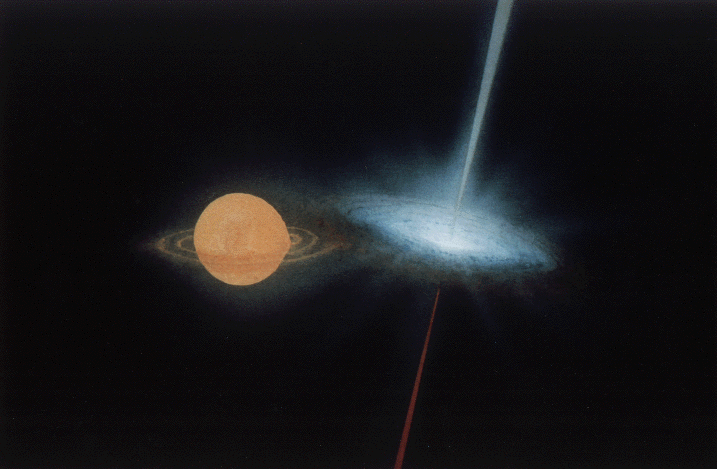The microquasar they observed, SS 433, is either a black hole or a neutron star in a binary system about 15,000 light-years from Earth. As it sucks in matter from its run-of-the-mill stellar companion, SS 433 is not only surrounded by a hot, swirling accretion disk of material, it also shoots out jets at 26 percent the speed of light. SS 433 is one of only about a dozen identified microquasars in the Milky way, and one of only a few of those from which gamma rays —an extremely high-energy form of light — have been seen.
Even though microquasars sit inside our own galaxy, they are still small and difficult to see. But “SS 433 is right in our neighborhood,” said Jordan Goodman of the University of Maryland, who also serves as U.S. lead investigator and spokesperson for the High-Altitude Water Cherenkov Gamma-Ray Observatory (HAWC) collaboration, in a press release. “So, using HAWC’s unique wide field of view, we were able to resolve both microquasar particle acceleration sites.” These two sites are the ends of the microquasar’s jets, where the researchers believe that emission from electrons interacting with light from the cosmic microwave background (CMB), which permeates the universe, is responsible for the gamma rays. This process, called inverse-Compton scattering, boosts the normally low-energy CMB photons to the extremely high energies of gamma rays.
This is a newfound way to produce high-energy gamma rays in microquasars. The discovery was made possible by the fact that SS 433’s jets are not pointed directly toward Earth, allowing the astronomers to spot the two different ends of the jets, which isn’t possible when an object’s jets are pointed at us, rather than sideways.
“SS 433 is an unusual star system and each year something new has come out about it,” said Segev BenZvi of the University of Rochester, and a co-author of the study.
To make the discovery, the team used more than 1,000 days of data from the Puebla, Mexico, HAWC Observatory. HAWC can study about 15 percent of the sky at once, scanning for the “air showers” that result when gamma rays and cosmic rays enter our atmosphere and lose energy as they bounce around amidst the air molecules. HAWC uses more than 300 steel tanks 13 feet (4 meters) high and 24 feet (7.3 m) in diameter filled with water. As particles from an air shower hit the water, they generate Cherenkov radiation, which is a blue glow that occurs because the particles are traveling faster than the speed of light in the water, which is lower than the speed of light in a vacuum or air. (Think the same process that creates a sonic boom, but for light, not sound.) Detectors inside the tanks look for this glow, recording it so researchers can determine where it came from.
Quasars are big and bright, but also far away, meaning they are more difficult to study than objects nearer to Earth. Microquasars are closer and smaller — and because they are smaller, they change much more quickly, which makes it easier to chart what’s going on inside. What might take months or years to happen in a quasar could happen in hours or days in a microquasar. Research has shown that these systems can then be scaled up to learn about their massive counterparts in other galaxies.
But “looking at only one kind of light coming from SS 433 is like seeing only the tail of an animal,” said co-author Ke Fang of Stanford University. “Thus, we [will] combine all of its signals, from low energy radio to X-ray, with new high-energy gamma ray observations, to find out what kind of beast SS 433 really is.”
And from there, “we can improve our understanding of particle acceleration in SS 433 and its giant, extragalactic cousins, called quasars,” said Goodman.

Want to learn more about pulsars and other extreme objects in our universe? Check out our free downloadable eBook: Exotic objects: Black holes pulsars, and more.











